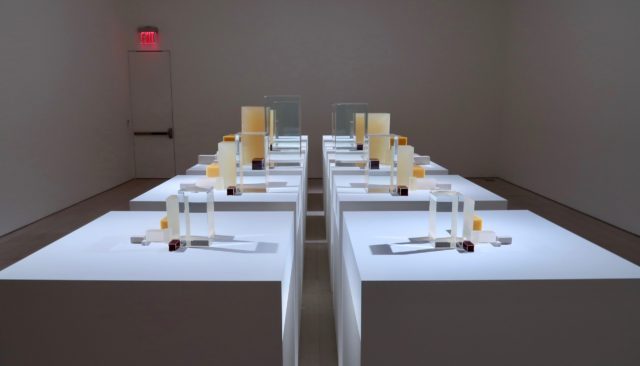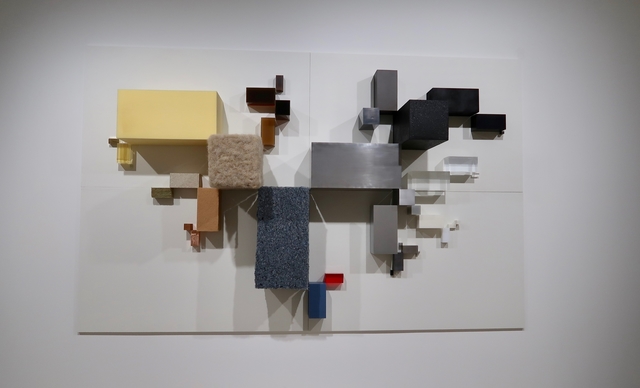DRIFT: FRAGILE FUTURE
The Shed, the McCourt
545 West 30th St. at Eleventh Ave.
Wednesday – Sunday through December 19, exhibition $25, Drifters and exhibition $35
Includes admission to Ian Cheng: Life After BOB
646-455-3494
theshed.org
online slideshow
Since 2007, the Amsterdam-based duo DRIFT, a partnership between Lonneke Gordijn and Ralph Nauta, have been exploring the intersection and interdependence of humans, nature, and technology. Their environmentally conscious, multidimensional works are like individual ecosystems that present hope for a future potentially doomed by climate change. Continuing through December 19 at the Shed at Hudson Yards, Fragile Future is a wonderland of experiential installations, presented by Superblue, which specializes in immersive art.
The exhibition begins with Fragile Future, a light sculpture with a modular system based on the growth of dandelions, constructed from LED lights, phosphor bronze, printed circuit board, and the hairs and seeds of dandelions themselves. Coded Coincidence consists of dozens and dozens of beaded lights that move about a long, rectangular, netted space, sudden gusts of air making them mimic the flight of elm seeds in the spring. There’s an emotional aspect to the movement as they travel in groups and gather in a corner, or, with a kind of sadness, one gets trapped in the netting, alone until it can be freed and join the rest of the herd.
Ego might be composed of nylon fiber, ultra-high molecular weight polyethylene fiber monofilaments, polyester, and polyvinyl fluoride and run by motors set to specific algorithms, but it seems to have an organic life of its own. Created for Nederlandse Reisopera’s production of Monteverdi’s opera L’Orfeo, about the love between Orpheus and Eurydice and his descent into the underworld, Ego is a monumental handmade woven block that rises, falls, spreads out, collapses, and twists and turns as if magically floating through space, evoking human emotions amid a gentle soundscape. Describing its construction, Gordijn explains in a Drift video, “It depends on how that ego is shaped, how flexible it is, or how rigid it is. Because if it is rigid, there is only one truth, and if it’s flexible, you can move along with what is needed in order for it to accept certain truths or accept how life is or how the world is being built. And I think it’s a big difficulty in everybody’s life to be flexible in your vision and to be flexible in your perspective. But we have to be flexible, and I like that about Ego, that it can be a very rigid block but it can also completely change. It can be a solution.”
The next room is filled with “Materialism,” a collection of reverse-engineered sculptures that reduce such consumer products as a Big Mac menu, a coffee cup, an iPhone, a pencil, and a bicycle into colored blocks based on the size of their raw materials, resulting in miniature architectural models meant to reveal how we exploit the earth and its labor force.
In the two-channel, twelve-minute film Drifters, Drift’s iconic concrete blocks float through New York City at one end of a long room and across mountains, rivers, and forests at the other end, searching for where they came from and what awaits them.
The pièce de resistance takes place in the McCourt, the Shed’s 17,000-square-foot McCourt performance venue, only at certain times and with an extra charge, so plan your visit carefully. Four levitating Drifters, real versions of the blocks from the film in the previous room, move slowly throughout the space for more than an hour, set to a droning soundtrack by Anohni, the English singer-songwriter who used to lead the band Antony and the Johnsons. The blocks are floating without wires, engaged in a butoh-like dance as they very (very) slowly flip, lower, and rise, sometimes dangling just overhead. Occasionally they gently bump into each other in a kind of soft kiss. The audience can walk around the area, sit in folding chairs, or lie down on their backs on the floor as these monoliths put on a mesmerizing show that could be an outtake from Stanley Kubrick’s 2001: A Space Odyssey. During the performance, I asked Gordijn how they did it. After offering two guesses that she quickly said no to, I suggested a third, which she simply smiled at. It’s extraordinarily peaceful and relaxing while also instilling hope for a future where humans, nature, and technology can exist together in harmony.
[On December 10 and 11, Ego will be activated by special dance performances, featuring Company Wo. (Daniel Kersh, Marcella Ann Lewis, Erika Choe, Jordan Demetrius Lloyd, and Myssi Robinson) from 11:30 to 5:00 and Project-TAG (Mizuho Kappa) from 5:30 to 8:00 on Friday and Limón Dance Company (Jessica Sgambelluri) from 11:30 to 2:00 and Battery Dance (Durgesh Gangani, Jillian Linkowski, Razvan Stoian, Randall Riley, Sarah Housepian, and Vivake Khamsingsavath) from 2:30 to 8:00 on Saturday.]

Drift exhibit at Pace features self-portraits of founders Lonneke Gordijn and Ralph Nauta (photo by twi-ny/mdr)
DRIFT MATERIALISM: PAST, PRESENT, FUTURE
Pace Gallery
540 West Twenty-Fifth St. between Tenth & Eleventh Aves.
November 5 – December 18, free
www.pacegallery.com
In an April 2020 online Pace discussion with musician Lee Ranaldo — he was supposed to play live with Ego when it was previously at Pace but it was canceled because of the pandemic — Gordijn said about the lockdown, “One of the beautiful things I found in the last days or weeks, actually, was that I realized that every night at a certain time, a group of crows is flying the same circles as if they’re all waiting for each other. Every day it is around 8:00, before sunset. This sort of connection with a place, where you start to get to know the animals, the plants, and the particularities, that is what I would love to explore more and the relationship that you can have with that.”
It is that kind of worldview that makes Drift’s work so compelling. In conjunction with Drift: Fragile Future, Pace is presenting “Drift Materialism: Past, Present, Future,” which expands on the “Materialism” room at the Shed. Continuing through December 18, the small show features sculptures that resemble Russian Constructivism filtered through children’s blocks. For the large-scale wall hanging 1980 Beetle, Gordijn and Nauta took apart a Volkswagen and put it back together. The resulting blocks represent forty-two materials, reduced to their accumulated mass.

DRIFT, 1980 Beetle, 2021 (photo by twi-ny/mdr / © DRIFT)
Drift usually deconstructs inanimate objects, but two new works explore the molecular elements of the human body, side-by-side self-portraits of Gordijn and Nauta that are exactly equal. In the back room, the augmented reality Block Universe consists of a plexiglass sun surrounded by planets; the gallery supplies iPads that depict orbiting Drifters and other elements. The title comes from the theory that everything is happening at once, that past, present, and future exist in unison.
“We’re not having relationships with the materials and objects around us anymore,” Nauta explains in a Drift video. “And if you start losing the connection with this, you’re going to be very unhappy, because you lose the wonder in life.”
Next up is Drift’s kinetic sculpture Amplitude, a permanent commission slated to go on view at 45 Rockefeller Plaza, providing yet more wonder.